I know that I am a foreigner living and working in Cambodia but I don’t like being labelled as a tourist or being placed in the same group as the “elephant-pant-wearing-travellers”. However, in Siem Reap there are certain tourist activities that you have to do and one of them is to visit Angkor Wat Archaeological Park.
I held off doing this for three months as I arrived in January during peak tourist season when the town was crawling with overweight, tattooed, pink people, sweating their way around the sights and markets. I couldn’t bear the thought of sharing the temple experience with tuk tuk loads of them or coachloads of Chinese and Korean tourists. I took the opportunity to buy my seven-day pass to the temples during the Easter holidays and had a month to use the ticket. For my first day I treated myself to a guide and a tuk tuk and also for the ride out to Banteay Srei but for other days I used my trusty Cambodian bicycle! After hearing my friends talking about the temples, it was a great experience to finally see Angkor Wat for myself. Nothing prepared me for the scale of the place; until I came here, I thought that Angkor Wat was just a big temple complex but the archaeological site is 400 square kilometres and to explore every temple (there are around 1,000) would take a lifetime. I have also learnt that this site was an enormous city built with an impressive infrastructure to support a population of around a million people including an irrigation system, hospitals, roads, rest houses and housing.
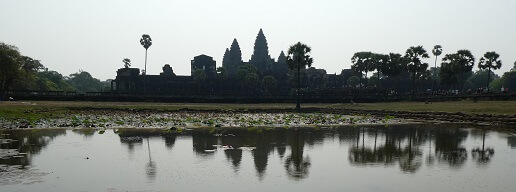
There is plenty written about the history of the temple structures and I am not going to regurgitate it all here. The sheer scale of the buildings and the beautiful setting in the tropical forest were the most impressive things and I have to say that I fell in love with the smaller sites where there were fewer people visiting. I have put together a very brief potted history about the temples I visited in the chronological order that they were built which is detailed below. If history isn’t your thing then just enjoy the photos!
The Khmer kingdom was founded in AD 802 by King Jayavarman II (AD 770 – 835) and he established his capital in Hariharalaya about 15 km east of Angkor near the village of Roluos. The kingdom stretched from the Kulen Mountains to Tonle Sap lake, an area of 1,000 square kilometres across fertile floodplain and an area famous for rice production and fishing.
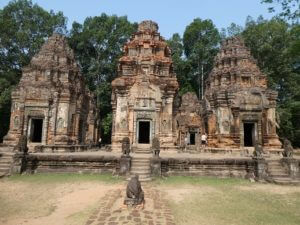 Preah Ko – was the first temple to be built in the city of Hariharalaya and was built to honour the king’s family and Shiva in AD 879 by King Indravarman I (AD 877 – 889), nephew of Jayavarman II. It’s a relatively simple construction of six brick towers on a sandstone platform. I cycled there from Siem Reap and was struck by the wonderful colour of the brickwork in the morning sun which is particularly stunning against the lush green backdrop of the forest.
Preah Ko – was the first temple to be built in the city of Hariharalaya and was built to honour the king’s family and Shiva in AD 879 by King Indravarman I (AD 877 – 889), nephew of Jayavarman II. It’s a relatively simple construction of six brick towers on a sandstone platform. I cycled there from Siem Reap and was struck by the wonderful colour of the brickwork in the morning sun which is particularly stunning against the lush green backdrop of the forest.
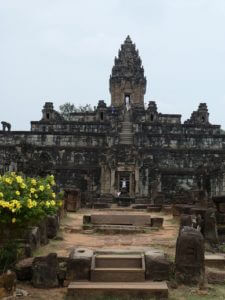 Bakong – was the first temple mountain built of sandstone by the Khmer rulers in the late 9th century and it was the state temple of King Indravarman I. In Hindu tradition the temple mountain is a representation of the sacred Mt.Meru and in some temples the 5 peaks of Mt.Meru are represented (Angkor Wat for example). The temple was built around a central chamber which housed an image of the deity being worshipped. The whole structure was a representation of the universe and the symmetry, orientation and decoration were designed to provide a harmonious and auspicious place for worship. In the times of the Angkor Empire, only the King, his priests and nobles were allowed inside the temples – it’s a bit different now with 2.5 million people visiting the Angkor site every year! Indravarman’s son Yasovarman (AD 889 -910) moved the state capital from Roluos to the place known as Angkor, north of Siem Reap.
Bakong – was the first temple mountain built of sandstone by the Khmer rulers in the late 9th century and it was the state temple of King Indravarman I. In Hindu tradition the temple mountain is a representation of the sacred Mt.Meru and in some temples the 5 peaks of Mt.Meru are represented (Angkor Wat for example). The temple was built around a central chamber which housed an image of the deity being worshipped. The whole structure was a representation of the universe and the symmetry, orientation and decoration were designed to provide a harmonious and auspicious place for worship. In the times of the Angkor Empire, only the King, his priests and nobles were allowed inside the temples – it’s a bit different now with 2.5 million people visiting the Angkor site every year! Indravarman’s son Yasovarman (AD 889 -910) moved the state capital from Roluos to the place known as Angkor, north of Siem Reap.
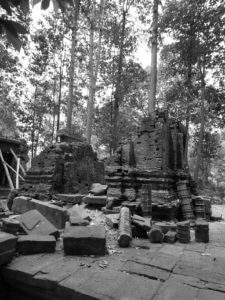 Prei Monti – nestling in the forest along a narrow trail about 1-2 km from Bakong, the smallest temple in the Roluos group and not on the tourist trail at all. I loved it as I was there all alone – just me on my bike!
Prei Monti – nestling in the forest along a narrow trail about 1-2 km from Bakong, the smallest temple in the Roluos group and not on the tourist trail at all. I loved it as I was there all alone – just me on my bike!
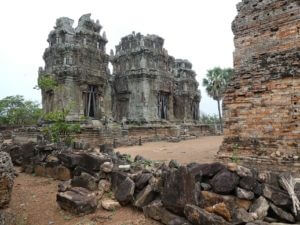
Phnom Krom and Phnom Bok – two of the three hill temples all built of stone and in a similar style at the end of 9th century by King Yasovarman. These are Hindu temples dedicated to Shiva, Vishnu and Brahma. The third hill temple Phnom Bahkeng formed the centre of the new capital city at Angkor and is now the most popular place to watch an Angkor sunset – I did not go there.
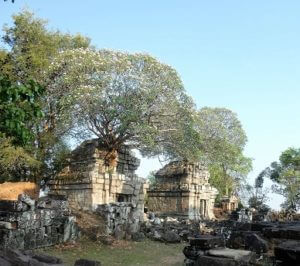
The problem with hill temples is that you have to cycle to the hill and then walk up to the top. Phnom Bok it is about a 25 km ride from Siem Reap and then up 635 steps! You have to be nuts…but the view is worth the effort and the scent of the frangipani I will carry with me to the grave. At Phnom Krom you can also do some excellent birding in the lotus fields which surround the hill – get there early in the morning.
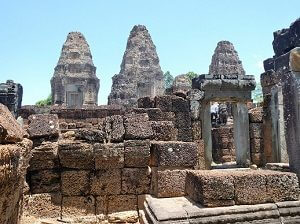
East Mebon – built in the 10th century by Rajendravarman II (AD 944 – 968) originally in the middle of a large reservoir, East Baray. A Hindu temple dedicated to Shiva in AD 953 with a north – south orientation and which could only be reached by boat. 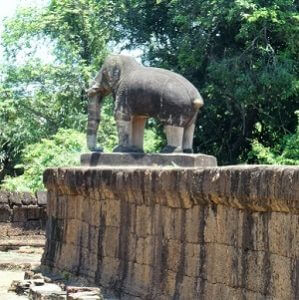 It’s a 3-tiered structure of sandstone platforms with brick-built towers and wonderful elephants standing guard at the corners of each terrace. I wished the reservoir was still in existence full of lotus flowers – it must have looked wonderful.
It’s a 3-tiered structure of sandstone platforms with brick-built towers and wonderful elephants standing guard at the corners of each terrace. I wished the reservoir was still in existence full of lotus flowers – it must have looked wonderful.
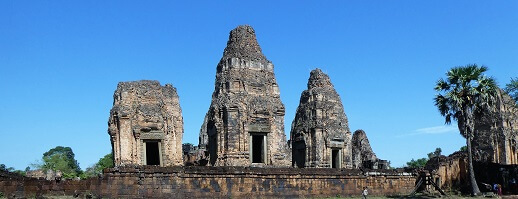 Pre Rup – is just down the road, a few hundred metres from East Mebon and was the state temple of Rajendravarman II and dedicated in AD 961-2. Built of the same materials as East Mebon – wonderful colours at sunset. You can get into the park after 17.30 for free and so can see the sunset from this vantage point.
Pre Rup – is just down the road, a few hundred metres from East Mebon and was the state temple of Rajendravarman II and dedicated in AD 961-2. Built of the same materials as East Mebon – wonderful colours at sunset. You can get into the park after 17.30 for free and so can see the sunset from this vantage point.
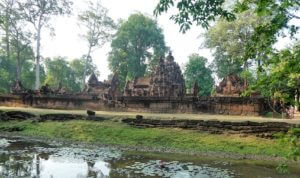 Banteay Srei – started around AD 967 and called the “Citadel of Women”; a Hindu temple dedicated to Shiva and one of the few Angkorian temples not to have been commissioned by a king but by a Brahman. It has exquisite stone carvings said by some to be the finest in the world and possibly done by women.
Banteay Srei – started around AD 967 and called the “Citadel of Women”; a Hindu temple dedicated to Shiva and one of the few Angkorian temples not to have been commissioned by a king but by a Brahman. It has exquisite stone carvings said by some to be the finest in the world and possibly done by women.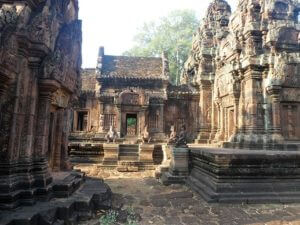 A wonderful pink sandstone building surrounded by forest – I got here very early one morning and the parrots were shouting in the tops of the huge trees that surround the site. It was a magical visit. This temple is about an hour from Siem Reap by tuk tuk and well worth the effort to get to.
A wonderful pink sandstone building surrounded by forest – I got here very early one morning and the parrots were shouting in the tops of the huge trees that surround the site. It was a magical visit. This temple is about an hour from Siem Reap by tuk tuk and well worth the effort to get to.
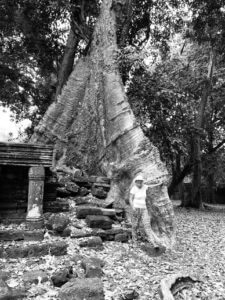 Phimeanakas – built around the end of the 10th century and started by Rajendravarman II and completed by Suryavarman I. A 3-tiered pyramid Hindu temple set inside the grounds of the royal palace. Well worth wandering around this area as there are magnificent cotton silk trees to be seen.
Phimeanakas – built around the end of the 10th century and started by Rajendravarman II and completed by Suryavarman I. A 3-tiered pyramid Hindu temple set inside the grounds of the royal palace. Well worth wandering around this area as there are magnificent cotton silk trees to be seen.
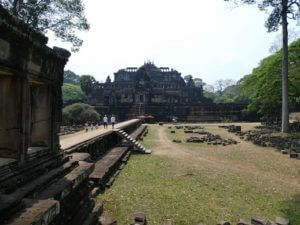 Baphuon – has a wonderful long causeway on the approach to this 3-tiered mountain temple built in the mid-11th – early 12th century by Udayadityavaram II (AD 1050 – 1066).
Baphuon – has a wonderful long causeway on the approach to this 3-tiered mountain temple built in the mid-11th – early 12th century by Udayadityavaram II (AD 1050 – 1066).
The remarkable story attached to this temple is that before civil war broke out in 1970, the temple was taken apart stone by stone, each stone labelled and the plan was to reinforce the core of the structure and to rebuild it. However, work was abandoned and during the rule of the Khmer Rouge all the plans were lost. Another restoration plan was started in 1996 and it took 16 years to piece together the stones and it was finally opened in 2011.

Angkor Wat – the iconic symbol of Cambodia was built in the early 12th century by Suryavarman II (AD 1113 – 1145) and dedicated to Vishnu. It was a funerary temple for King Suryavarman II which is why it is west-facing and not east-facing as are the majority of Hindu temples. It only took thirty years to build with a workforce of 300,000 plus 6,000 elephants. It is the height of the temple mountain design with the five peaks in the shape of lotus flowers and the moat representing the oceans at the edge of the world.
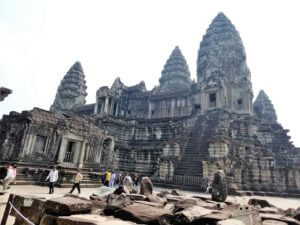
The walls of the galleries are covered in wonderful friezes depicting the stories from the traditional Hindu epices. In AD 1177 Angkor Wat was sacked by the Chams and it is thought that the building remained relatively well-preserved because the huge moat prevented the jungle from reclaiming the temple.
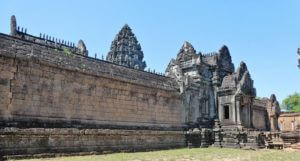 Banteay Samre – is out of the main park and on the road to Phnom Bok. It is worth visiting these slightly out of the way temples as they are less crowded and you can take your time to soak up the atmosphere and admire the architecture. Banteay Samre was built in the early 12th century by Suryavarman II and finished by Jaryavarman VII (AD 1181 – 1218). This period is considered to be the height of the Angkor kingdom under Jayavarman VII and it was the largest empire of its kind in the world.
Banteay Samre – is out of the main park and on the road to Phnom Bok. It is worth visiting these slightly out of the way temples as they are less crowded and you can take your time to soak up the atmosphere and admire the architecture. Banteay Samre was built in the early 12th century by Suryavarman II and finished by Jaryavarman VII (AD 1181 – 1218). This period is considered to be the height of the Angkor kingdom under Jayavarman VII and it was the largest empire of its kind in the world.
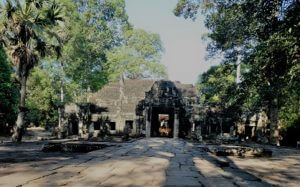 Banteay Kdei – built by Jayavarman VII in the mid-12th early 13th century and called the “Citadel of monks”. It’s a Buddhist temple built in the Bayon style and was a monastery. It is opposite the Srah Srang reservoir which was the king’s bathing pool.
Banteay Kdei – built by Jayavarman VII in the mid-12th early 13th century and called the “Citadel of monks”. It’s a Buddhist temple built in the Bayon style and was a monastery. It is opposite the Srah Srang reservoir which was the king’s bathing pool.
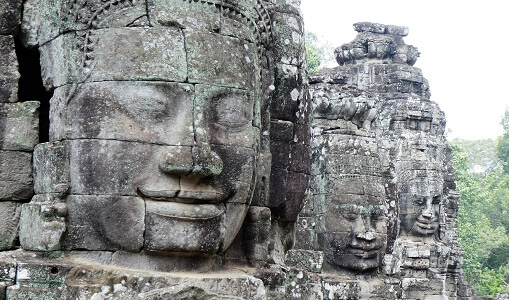
Bayon – famous for the fantastic faces on each side of the many towers, the temple was built by Jayavarman VII as his state temple; it was the only temple to be a Mahayana Buddhist temple and it was the last state temple built at Angkor.
 Ta Prohm – also built by Jayavarman VII in the Bayon style as a Mahayana Buddhist university and monastery. This temple has been left more or less as it was found with trees growing out of the ruins and has been used in numerous films and advertisements. It is very beautiful but very popular and always crowded.
Ta Prohm – also built by Jayavarman VII in the Bayon style as a Mahayana Buddhist university and monastery. This temple has been left more or less as it was found with trees growing out of the ruins and has been used in numerous films and advertisements. It is very beautiful but very popular and always crowded.
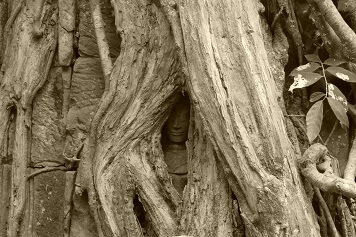
The fall of the Khmer Empire is thought to be due to a combination of circumstances. Population pressure was probably one cause, the forests had been depleted for firewood and the irrigation channels became silted up; the Black Death was also spreading through S E Asia. Finally, continuous assaults by forces from Thailand forced King Ponhea Yat to abandon Angkor Wat and the capital moved to Phnom Penh in the 15th century after the invasion and sacking of Angkor Wat by Thai forces in 1431.
The Phnom Penh Post published figures stating that 2.5 million tourists came to Angkor Wat in 2017, an increase of 16% on 2016. Revenue from ticket sales was $102 million, an increase of 72% on 2016 due to the entrance ticket price increase in February 2017. The environmental impact of the increased tourist numbers is huge. Many new hotels and resorts are springing up in the area and a new airport is planned to support more flights from China. Reports are that the demand for water is lowering the water table with all the associated problems that this brings. The infrastructure is not sufficiently developed to support the increase in tourist numbers; there is a lot of work to do on roads, waste disposal and water supply. The demise of the Angkor Dynasty could repeat itself.
©Copyright overthehils.com 2018

